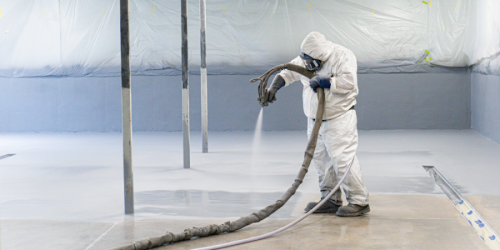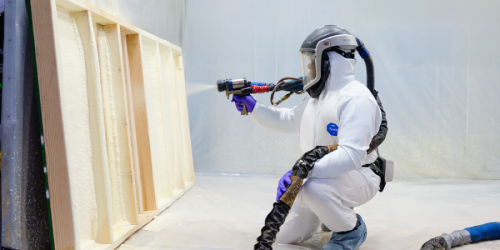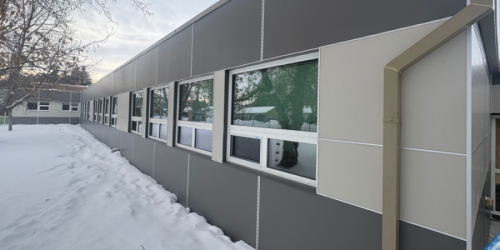Q&A Forums
Selling tips Post New Topic | Post Reply
| Author | Comments |
|---|---|
|
Ryan Rhoads
Posted: Mar 20, 2006 03:10 PM
|
Selling tips
I am currently starting my second year of buisness in the SPF industry and have had some trouble selling people on how much better the product is and even told them how the savings pays for itself in 4-5 yrs. I have even looked at house where they were putting in an indoor pool and told them all about moisture drive, mold and anything else I could think of. Yet people still do not go for it. I think people need hard facts of cost comparisons. Can anyone help me. Just to let everyone else know there is some good information in the Honeywell closed-cell foam brochure. Any advice is greatly appreciated.
|
|
Posted: Mar 22, 2006 09:35 PM
|
Be versitile that is the key to longevity in this biz. We have done some crazy things over the yrs. Everything from commercial roofs to displays. When driving in the residential market we need to be able to work together as an industry to educate architects builders and code enforcers and with that will come educated home buyers. Marketing that has worked for us is partisipation in local building associations and home shows, and most importantly good work will bring your most powerful marketing tool known as word of mouth. Hang in there our industry is going to see big growth in the near future driven by the outrageous energy costs.The thing that will help us the most is the code people getting their heads out of their butts and changing codes to efficiency ratings and not ridiculous R-values. Good luck give your self time it will work out I know its tough starting out. |
|
Posted: Mar 23, 2006 02:21 AM
|
re: code officials heads upass they just dont know,,,and need to be educated, flame and smoke were issues here.. so i provided a list of common construction materials and their flame and smoke numbers.. didjaknow that douglas fir has almost 4 times the flame spread number as foam..not near the smoke though..burning plastics make hellin smoke.. i also provide a copy of the JAMA (journal of the american medical association) article that states once manufactured foam is reletively inert and as safe as any plastic in your home..of which about 70% is plastics..it also states that burn tests show its smoke to contain the same schtuff that burning wood contains,,although the fire retardants and other goodies added to the polyols can produce some additional funky smoke vapors.. does anyone else feel the INDUSTRY should be doing this education: read the manufacturers and the trade associations? these folks want us to do this and the powers that be want answers from bigger turds than me.. where is the spfa,,the pda,,the api...(i left out the manufacturers) we need proactive lobbyists,,,we pay dearly for the raw materials...we need more than trade shows and web pages and the occassional news letter...they have the info,,,they are better "connected" than all of us..they are they folks the specifiers,architects, code officials, developers and energy rebate officials want to hear from..not this hick from the cornfield.. |
|
Ryan Rhoads
Posted: Mar 23, 2006 03:20 AM
|
I agree completely. foamdude if don't mind I think it would be of great benefit to everyone if you would post those figures on this site. If not please email them to me at bendriftin@excite.com. I know I have been asked numerous times about how flamable it is. Well I pick up a piece and show them that it is just as flamable as wood. Yet I have not been asked by a code official. I think we can all benefit from that information if you still have it on hand. Any one that copies the information please save it for you records becuase I know some day it will come handy. The other thing we need to compile, or so I think is REAL WORLD FIGURES. We need two houses that are side by side and identical floor plans, ONE WITH FOAM and one with fiberglass batts or blown or even one with blown cellulose. I blow cellulose but I know it is not what is best for the customer. People are cheap. If anyone can get two homes together I think I can get the foam free of charge, maybe even publicity. |
|
Ryan Rhoads
Posted: Mar 23, 2006 03:33 AM
|
The problem I see is that the industry does not have actual values. I recently received a brochure from Corbond. It states that under normal conditions that you will lose 296/hr BTU's of heat loss with 3in. of corbond foam insulation. (at low end it should be R-18) Versus 295 BTU/hr of heat loss with 5 1/2in. fiberglass insulation. Oak Ridge National Labarotory state that fiberglass. This does not make sense to me. Another thing. According to Oak Ridge National Laboratory, R-19 batt insulation perfectly intalled is actually R-17. How do building officials get away with allowing this. I do plan to become a member of the SPFA, I think we all should. They did lobby for us to provide foam to the bottom side of roofs to promote a longer lasting roof assembly. Where the problem lies is other than UCSC no other foam chemical manufactures provide us with the foam, the publicity, or the cload to go to places like habitat for humanities or rural houseing so that we can make real world comparisons. I know foam is better, you know foam is better, and they know foam is better yet the customer does not. LET'S GET DOCUMENTED COMPARISONS, THERMAL IMAGING, AND WHAT EVER ELSE IT TAKE TO CONVENCE THE REST OF THE PUBLIC. |
|
Trey Gibson
Posted: Mar 23, 2006 07:44 AM
|
I would also appreciate a copy of the flame and smoke ratings. Even though the foam product has been around a long time, it seems that if it is just now starting to gain popularity and increasing public acceptance. It takes money to lobby and bring these tests to the publics attention. The fiberglass industry has money and lobbyists to do this where as the foam manufacturers don't, or at least not at the magnitude of our competitors. It seems to me like this is somewhat a grass roots type of thing where the word is spreading through builders, homeowners and such. I have not met a builder that has not at least heard of foam and know of its benefits. Off my soapbox. About selling. I would def recommend building shows. I went to one with our supplier for only two hours on a Sat morning and met two builders that have turned out to be our best customers. Also, ask every builder you do business with and do a good job for if they could refer you to one of their friends. Every builder knows at the very least 3-5 more. Even though this industry is huge, it is small at the same time, everybody knows everybody and word travels fast so do a good job, treat people right and your reputation will begin to precede you. |
|
Trey Gibson
Posted: Mar 23, 2006 07:44 AM
|
I would also appreciate a copy of the flame and smoke ratings. Even though the foam product has been around a long time, it seems that if it is just now starting to gain popularity and increasing public acceptance. It takes money to lobby and bring these tests to the publics attention. The fiberglass industry has money and lobbyists to do this where as the foam manufacturers don't, or at least not at the magnitude of our competitors. It seems to me like this is somewhat a grass roots type of thing where the word is spreading through builders, homeowners and such. I have not met a builder that has not at least heard of foam and know of its benefits. Off my soapbox. About selling. I would def recommend building shows. I went to one with our supplier for only two hours on a Sat morning and met two builders that have turned out to be our best customers. Also, ask every builder you do business with and do a good job for if they could refer you to one of their friends. Every builder knows at the very least 3-5 more. Even though this industry is huge, it is small at the same time, everybody knows everybody and word travels fast so do a good job, treat people right and your reputation will begin to precede you. |
|
Posted: Mar 23, 2006 07:41 PM
|
"The problem I see is that the industry does not have actual values. I recently received a brochure from Corbond. It states that under normal conditions that you will lose 296/hr BTU's of heat loss with 3in. of corbond foam insulation. (at low end it should be R-18) Versus 295 BTU/hr of heat loss with 5 1/2in. fiberglass insulation. Oak Ridge National Labarotory state that fiberglass. This does not make sense to me." R value is R value...and the figures you cite i believe are in reference to "IDEAL" conditions,,,that is 70 degress in and 68 degrees out,,no wind...(not the real world here in the cornfield,,,the wind is moving 3/4s of the time)so an r19 of closed cell foam...an r19 of open cell foam...an r19 of fiberglass..an r19 of shredded cotton will all perform the same (kinda like how the Rvalue rateing sytem was derived,,under ideal lab conditions but they had to come up with some sort of standardization) BUT PUT WIND ON THE STRUCTURE.....thats when things change...drastically in some cases.... that chart should reference more real world conditions, as i remember, showing a significant differential of btu loss as the wind blew and the temp fell...but at any state of equilibrium an r19 of this works as well as an r19 of that .... :) |
|
Posted: Mar 23, 2006 07:57 PM
|
TO THE MODERATOR: may i post a web link in the forum? some forums do,,some dont... please advise.. |
|
Posted: Mar 23, 2006 07:59 PM
|
join your local NAHB...get to a meeting or two.. when things are slow,,,cold call,,go to the jobsite,,introduce yourself,,leave a card..talk truth/facts if they give you the time..if not just the fact you were there will maybe make em think foam,,at least for a while or a moment. press release: factual information about you,,the service you provide..the products you use,,be brief make em have to call you.. TRADE SHOWS: these have paid dividends for me too...any where you can get at THE END USER..if the owner of the home wants foam bad enough he will get foam...most builders just wanna build cheap.. never bad mouth your competition,,smile and say they do a good job, or their nice people or they spray a good product,,or sumpthin positive...even if it hurts,,,it shows maturity and integrity.. when you get a job,,do it well..on time..correctly,,leave the site better than when you arrived..get to know the other trades...(the heating and cooling contractors have sent me many a lead) if possible..invoice under bid a time or two...this really will get a builders eyes open..("under bid...this mans good schtuff!") learn all you can,,read all you can..listen all you can... |
|
Posted: Mar 24, 2006 02:46 AM
|
http://www.dps.state.la.us/sfm/planreview/Flame-Spread%20Ratings.htm cut and paste to your browser... enjoy |
|
Gerry Wagoner
Posted: Mar 24, 2006 11:53 AM
|
Hello. According to recent testing at ORNL, fiberglass was compared to spray foam in an attic situation. Get this: At 0°... Fiberglass retained 47% of it's stated R-value Open-cell foam retained 74% Closed-cell foam retained 84% That is HIGHLY observable data. Fiberglass is at best a pink air filter. gcw |
|
Posted: Mar 24, 2006 07:39 PM
|
gcw..i too jumped up and down till i read the data and considered what it said... foams sprayed to roof subdeck: ie: conditioned attic space fiberglass to attic drywall lid(floor of attic): ie: unconditioned attic space the article then goes on to explain (see how the foam insulated ATTIC AREA were cooler/warmer than the fiberglass insulated ATTIC LID...duh...ya think the conditioned space had better temps than the unconditioned space? duh again once again compareing apples to oranges. this study only showed the performance of a conditioned space attic over an unconditioned attic space,, showing it to be benificial to those with hvac schtuff in the attic... it is not an equal comparison of materials and most importantly equal applications.. we have to read carefully and not misinterpate the data...if a salesman gave you the paper and his synopsis of what it said..READ IT EVEN MORE CAREFULLY,,hee hee a better comparative study would have been to attemp (febile attempt i might add)to create a conditioned attic space with fiberglass. then the data could be used to look at performance... |
|
Gerry Wagoner
Posted: Mar 26, 2006 10:25 AM
|
Dear Dude: I agree. It was not an apples to apples comparison. It did however, highlight the stated R-values versus actual ones for the materials. That is worth something. keep the trigger pulled.. gcw |





























